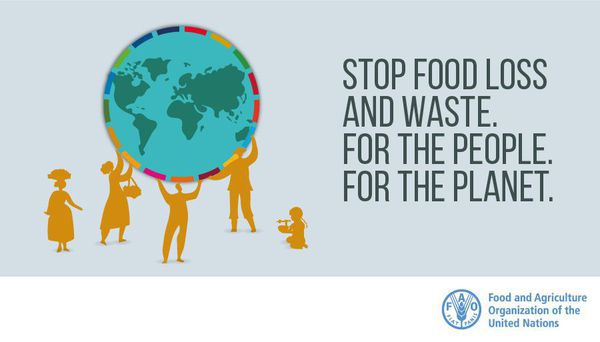Update
Food Loss and Waste and The Role of Geneva
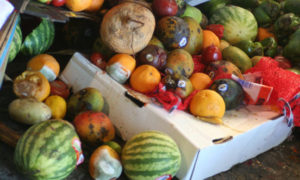
Last updated: 18 Apr 2024
According to the United Nations Environment Programme (UNEP), substantial amounts of food are produced but not eaten, causing negative environmental, social and economical impacts. Estimates also suggest that 8-10% of global greenhouse gas emissions are associated with food that is not consumed. Reducing food waste at the retail, food service and household levels can provide multi-faceted benefits for both people and the planet.
If we want to get serious about tackling climate change, nature and biodiversity loss, and pollution and waste, businesses, governments and citizens around the world have to do their part to reduce food waste. Reducing food waste would cut greenhouse gas emissions, slow the destruction of nature through land conversion and pollution, enhance the availability of food and thus reduce hunger and save money at a time of global recession.
– Inger Andersen, Executive Director of UNEP, 4 March 2021
Food Loss and Waste
According to the United Nations and the Food and Agriculture Organization (FAO), around 14% of food produced is lost between harvest and retail worldwide. Significant quantities are also wasted in retail and at the consumption level. According to UNEP, the world already produces enough food to feed everyone on the planet and according to the recent Food Waste Index Report 2021, over 17% of food in total is wasted. According to FAO, the global volume of food wastage is estimated at 1.6 billion tons of “primary product equivalents.” Total food wastage for the edible part of this amounts to 1.3 billion tons.UNEP found that the global average of 74 kg per capita of food wasted each year is similar from lower-middle-income to high-income countries, which means that most countries have room to improve. This has an impact on the environment:
- Food wastage’s carbon footprint is estimated at 3.3 billion tons of CO2 equivalent of GHG released into the atmosphere per year.
- The total volume of water used each year to produce food that is lost or wasted (250km3) is equivalent to the annual flow of Russia’s Volga River, or three times the volume of Lake Geneva.
- Similarly, 1.4 billion hectares of land (28% of the world’s agricultural area) is used annually to produce food that is lost or wasted.
- Agriculture is also responsible for a majority of threats to at-risk plant and animal species tracked by the International Union for Conservation of Nature (IUCN).
- A low percentage of all food wastage is composted. Much of it ends up in landfills and represents a large part of municipal solid waste. Methane emissions from landfills also represent one of the largest sources of GHG emissions from the waste sector.

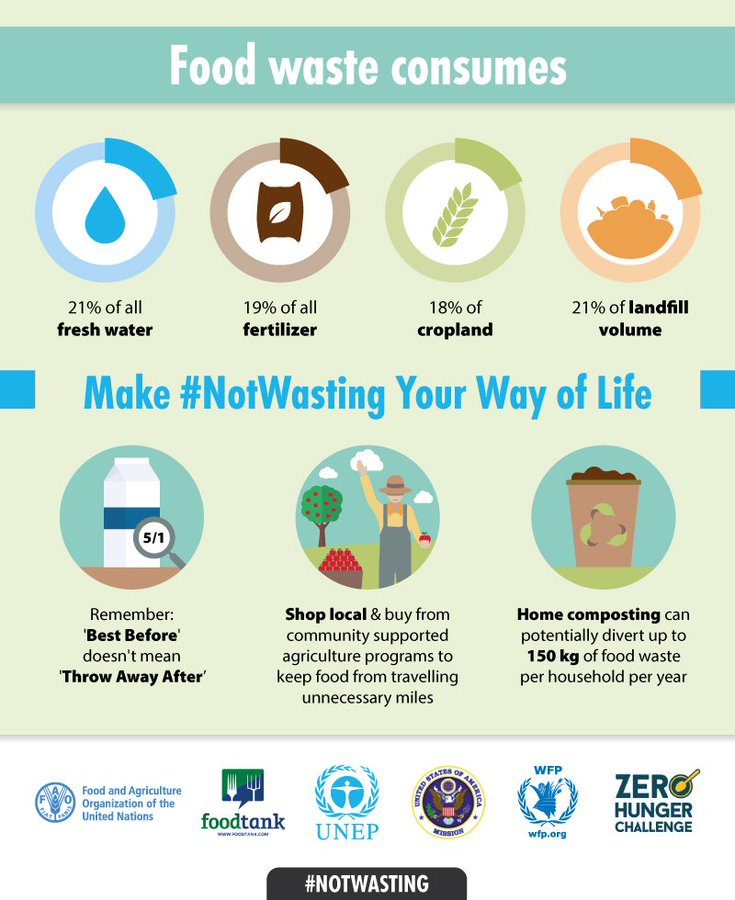
Source: UNEP, 2016
The later food is wasted along the chain, the greater its environmental impact because we have to take into consideration the energy and natural resources expended in processing, transporting, storing and cooking food. Around 38% of total energy consumption in the global food system is also utilized to produce food that is either lost or wasted. In addition, it takes seeds, soil and the labor of farmers to produce food, not to mention the fuel that is needed to transport it. All of these resources are lost when food is wasted. Food waste that ends up in landfills produces a large amount of methane, a more powerful greenhouse gas than even CO2, thus contributing to climate change. Policymakers can improve the chances of achieving climate goals and limiting global warming to 1.5°C by making more specific commitments to transforming national food systems.
With agriculture accounting for 70% of the water used throughout the world, food waste also represents a great waste of freshwater and ground water resources. It is said that a volume of water roughly three times the volume of Lake Geneva is used just to produce food that is not eaten. By throwing out one kilogram of beef, you are essentially wasting 50,000 liters of water that were used to produce that meat. In the same way, nearly 1,000 liters of water are wasted when you pour one glass of milk down the drain. If you look at land usage, around 1.4 billion hectares of land, roughly a third the world’s total agricultural land area, is used to grow food that is wasted. Millions of gallons of oil are also wasted every year to produce food that is not eaten. All these do not even take into account the negative impacts on biodiversity due to activities like monocropping and converting wild lands into agricultural areas.
The report “Enhancing Nationally Determined Contributions (NDCs) for Food Systems” indicates that all the elements and activities that relate to the production, processing, distribution, preparation and consumption of food account for up to 37% of all greenhouse gas emissions; continuing on a business-as-usual trajectory will single-handedly exhaust the 1.5°C compatible emissions budgets for all sectors. Although 89% of NDCs mention agriculture production, agriculture emissions reduction targets are mainly included in wider land-use targets. More notably, other actions in the food system, such as reducing food loss and waste, or shifting to more sustainable diets, are widely ignored, despite presenting the combined opportunity to reduce emissions by as much as 12.5 Gt CO2e – the equivalent of taking 2.7 billion cars off the road.
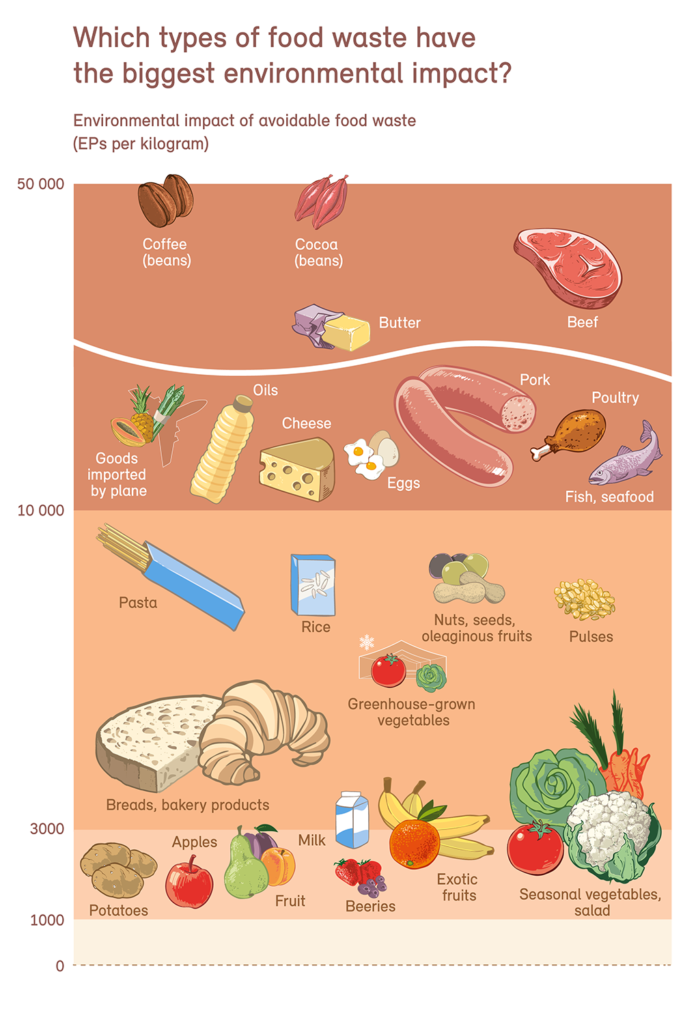
International Database
The Food Loss and Waste Database is the largest online collection of data on both food loss and food waste and causes reported throughout the literature. The database contains information from openly accessible reports and studies measuring food loss and waste across food products, stages of the value chain, and geographical areas. In October 2019, more than 480 publications and reports, which have produced more than 20,000 data points, were included. Data can be queried, downloaded, and plotted in an interactive and structured way. The database can be used by anyone who wishes to know more about food losses and waste.
International Day of Awareness of Food Loss and Waste Reduction
Each year on 29 September, the International Day of Awareness of Food Loss and Waste. Reducing food loss and waste is of significant importance as it contributes to the realization of broader improvements to agri-food systems toward achieving food security, food safety, improving food quality and delivering on nutritional outcomes. Reducing food loss and waste also contributes significantly to the reduction of greenhouse gas emissions, as well as pressure on land and water resources. Find more information and related events for each edition:
- International Day of Awareness of Food Loss and Waste 2023
- International Day of Awareness of Food Loss and Waste 2022
- International Day of Awareness of Food Loss and Waste 2021
- International Day of Awareness of Food Loss and Waste 2020 | The first edition
Food Loss and Waste in the SDGs
Reducing food losses and waste is critical to achieving the UN Sustainable Development Goals (SDGs). Specifically, SDG 12 aims to ensure sustainable consumption and production patterns, which contains a wide range of targets related to food waste.
SDG Target 12.3
By 2030, halve per capita global food waste at the retail and consumer levels and reduce food losses along production and supply chains, including post-harvest losses. In order to measure food waste and losses, two indices have been proposed:
Sub-Indicator 12.3.1.a – Food Loss Index
The Food Loss Index (FLI) focuses on food losses that occur from production up to (and not including) the retail level. It measures the changes in percentage losses for a basket of 10 main commodities by country in comparison with a base period. The FLI will contribute to measure progress towards SDG Target 12.3.
Sub-Indicator 12.3.1.b – Food Waste Index
A proposal for measuring Food Waste, which comprises the retail and consumption levels is under development. UNEP is taking the lead on this sub-indicator.
Actions
Actions are required globally and locally to maximize the use of the food we produce. The introduction of technologies, innovative solutions (including e-commerce platforms for marketing, retractable mobile food processing systems), new ways of working and good practices to manage food quality and reduce food loss and waste are key to implementing change. To stop food waste, changes have to be brought in at every stage of the process – from farmers and food processors to supermarkets and individual customers. As a first step, priority should be given to balancing production with demand. This essentially translates to lesser use of natural resources to produce food which is not needed.
More efforts should also go into developing better food harvesting, storing, processing and distributing processes. If oversupply happens, steps should be taken to redistribute the food or to divert it to people who are in need. Additionally, the different actors can reduce their “food footprint” by identifying where waste occurs and taking steps to tackle the same. Fruits which are misshaped or “ugly” are not necessarily bad and can still be bought and used in dishes like soups. Consumers should also try to buy food in accordance with a meal plan so that they don’t end up wasting edible food. Food may be cheaper when you purchase in bulk, but in reality, you are not really saving money when all you are doing is chucking it in the bin at the end of the week.
If the food still ends up unfit for human consumption, it can be used for feeding livestock, saving precious resources that would have otherwise been used for producing commercial feed. If the food cannot be reused at all, then we should at least try to recycle it in a responsible manner instead of sending it to the landfills where it continues to rot.
Find out how your choices and actions can make a difference in the World Food Day Activity Book. You can also follow the journey of food from the farm to your table and the great efforts food heroes make to get it there, no matter the circumstances.
Role of Geneva
Organizations are listed in alphabetical order
International Geneva
Food and Agriculture Organization of the United Nations (FAO)
FAO has a liaison office in Geneva and FAO’s work on measurement and support to countries to take action to reduce food loss and waste is critical to tracking progress made by countries. In addition, efforts by FAO and UNEP are currently underway to measure progress toward achieving SDG 12.3 through two separate indices – the Food Loss Index (FLI), led by FAO; and the Food Waste Index (FWI), led by UNEP.
Global Alliance for Improved Nutrition (GAIN)
Headquartered in Geneva, GAIN is a Swiss-based foundation that works closely with governments, businesses and civil society to tackle global malnutrition and to transform food systems to provide everyone better access to nutritious, safe and affordable food. Among other issues, GAIN conducts studies and organizes workshops on the theme of food loss and waste.
International Institute for Sustainable Development (IISD)
Aiming to provide a world where people and the planet thrive work, the work of IISD focuses on accelerate solutions for a stable climate, sustainable resources, and fair economies. Recognizing the complexity of today’s challenges, they work on sustainable solutions on various fields such as food and agriculture, nature-based solutions, and climate change. Among their many resources, they provide insights into the issue of food loss ans waste.
International Standard Organization (ISO)
ISO has more than 1,600 standards related to the food sector, with many more in development. International standards can help combat food loss and waste, by providing guidance to save resources. On this issue, UNEP and FAO participate in various ISO technical committees and have been involved in the development of some of these standards.
International Trade Centre (ITC)
The work of ITC on Food and Agri-Business build sustainable agricultural exports and strengthen intraregional trade by assisting farmers, communities and agri-food enterprises while ensuring sustainability. ITC is a member of the Global Initiative on Food Loss and Waste Reduction led by FAO.
Office of the High Commissioner for Human Rights (OHCHR, UN Human Rights)
The work of UN Human Rights to protect and promote the realization of the right to adequate food includes disseminating the international human rights standards and principles related to the right to food. Tackling food loss and waste from a human rights-based approach, OHCHR aims to provide guidance to Member States on laws, policies and action plans to promote the enjoyment of the right to food.
Special Procedures of the UN Human Rights Council
The UN Special Rapporteur on the right to food and the UN Special Rapporteur on the right to a clean, healthy and sustainable environment, who are independent experts under the Special Procedures of the Human Rights Council, address food loss and waste in their work by highlighting and promoting the human rights dimensions in food systems. The mandate of the Special Rapporteur on the right to food was created to address the need for an integrated and coordinated approach to promoting and protecting people’s right to food, acknowledging the food loss and waste generated by the current industrial agricultural model. The Special Rapporteur on the right to a healthy environment has highlighted in their report to the UN General Assembly the importance of healthy and sustainable food systems to ensure everyone’s right to adequate food.
United Nations Economic Commission for Europe (UNECE)
UNECE has addressed the food loss challenge since 2013 – including in view of enhancing the circular economy in its member states. Through the constant review of its quality standards for agricultural produce traded internationally and nationally, UNECE ensures that the quality of the produce used and traded is maintained along the entire supply chain. Food loss is therefore prevented and reduced. UNECE also focuses on the food lost in the trade process before it reaches the consumer and even retail.
United Nations Environment Programme (UNEP)
UNEP and partner organization WRAP recently published the Food Waste Index Report 2021. It looks at food waste that occurs in retail outlets, restaurants and homes – counting both food and inedible parts like bones and shells. The report presents the most comprehensive food waste data collection, analysis and modelling to date, and offers a methodology for countries to measure food waste. 152 food waste data points were identified in 54 countries.
Think.Eat.Save is a partnership between UNEP and FAO contributing to the Sustainable Food Systems Programme of the 10 Year Framework of Programmes on Sustainable Consumption and Production (10YFP), also known as the One Planet Network.
World Business Council for Sustainable Development (WBCSD)
WBCSD Food and Nature Program leads business efforts to accelerate the much-needed system transformation in the areas of food, nature and water. Under this programme, the FReSH initiative targets specifically food loss and waste, recognizing the critical need to address food loss and waste to improve food security, minimize the environmental footprint of the global food system and achieve the SDGs.
World Economic Forum (WEF)
Among the global issues covered by WEF is the “Future of Food” proving strategic analysis, trends and research on the topic.
World Food Programme (WFP) Office in Geneva
WFP work on sustainable livelihoods and ecosystems helps countries and the most vulnerable and food insecure communities manage natural resources sustainably such as soil conservation and fertility measures; water harvesting and flood control; agro-ecological productivity to reduce biodiversity loss; irrigation schemes; forestry and agroforestry management; and, access to clean water in arid and semi-arid contexts results in more diversified food, thereby complementing nutrition efforts. The restoration of degraded ecosystems boosts public health and reduces hardship in general.
WWF International
WWF works on projects that improve efficiency and productivity in food systems while reducing waste and shifting consumption patterns. WWF also builds public awareness on how we consider food.
Switzerland and Local Geneva
In Switzerland, the average annual food waste form farm to fork is of about 300 kg per capita, 2,564,500 tonnes in 2019 according to Swiss Federal Office for the Environment, of which 90 kg per capita at the households level.
Biovision
The CLEVER initiative created by the Biovision makes it possible to address the theme of responsible consumption with the public, especially young people.
Canton and City of Geneva
The Canton of Geneva imports approximately 80% of the commodities consumed by its population. The transport of food products is the third-largest flow of resources consumed in Geneva after building materials and energy products. The Canton of Geneva provides resources on food waste and the City of Geneva lists tools on learning how to adopt to a local and sustainable approach to eating.
Environmental Committee | Geneva Graduate Institute (IHEID)
The Environmental Committee of the Geneva Graduate Institute organizes a weekly free redistribution of unsold food from the campus cafeteria for their longstanding Save the Food Project.
Étudiant-es pour le développement durable (EDD) | University of Geneva
The association of the students for sustainable development aims to make the University of Geneva a greener environment and to raise awareness on the importance of sustainability. As part of their mission, every friday the association organizes for the students of the University a free distribution of unsold food from the Market of Plainpalais.
Fédération Romande des Consommateurs (FRC)
FRC provides tools for consummers to avoid food waste.
Free-Go Project
The Free-Go project, supported by the City of Geneva and Loterie Romande, is part of the fight against food waste, to raise awareness among Geneva households of the negative impact of our food waste on our environment. It offers those who wish to do so the opportunity to adopt new daily gestures to reduce their environmental footprint, while reinforcing social solidarity. In this way, Free-Go acts on the three dimensions of sustainable development.
Partage
Partage is a food bank created in 2005 by the Salvation Army, C.A.R.E., Caritas Genève, les Colis du Cœur and Emmaüs. It salvages food waste and provides them to different beneficiaries.
Swiss Federal Office for the Environment
The Swiss Federal Office for the Environment provides information on food waste in Switzerland. About 25% of the country’s nutrition-related environmental impact is caused by avoidable food waste. In 2013, the Swiss Federal Council adopted measures to reduce food waste as part of the Green Economy Action Plan. Among others, it has resulted in a stakeholder dialogue and the implementation of a number of initial actions. With the adoption of the Chevalley postulate (18.3829) on 5 March 2019, the National Council mandated the Federal Council to produce an action plan on food waste prevention.
WWF Switzerland
The Swiss organization of WWF provides resources and an app on food waste.
Zero Waste Geneva
Zero Waste Geneva is a community for those looking to reduce waste, preserve natural resources and create a more sustainable future! The organization offers workshops and resources on reducing food waste.
Learning

SDG Sub-Indicator 12.3.1.a – Food Loss Index
Online | FAO
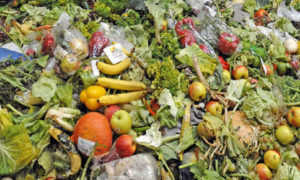
Food Loss Analysis
Online | FAO
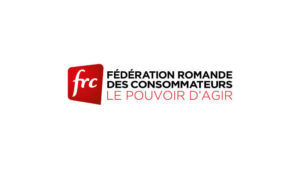
Gaspillage Alimentaire
Online | Fédération Romande des Consommateurs
Resources & Latest News
- Think.Eat.Save | UNEP Campaign
- Learn about food waste | Think.Eat.Save | UNEP
- Gaspillage alimentaire | Canton of Geneva
- Reducing food waste | City of Geneva
- Reducing Food Waste | WWF International
- Food Loss and Waste | WWF International
- Fight climate change by preventing food waste | WWF International
- Gaspillage alimentaire | WWF Switzerland
- Food Waste Index Report 2024 | UNEP | 27 March 2024
- Food Waste Backstage: Vue d’initiée sur une installation de traitement des déchets alimentaires | Natalia Krylova, UNIGE | March 2023
- Sustainable Food Cold Chain: Opportunities, Challenges and the Way Forward | FAO & UNEP | 12 November 2022
- Spoiler alert: Minimizing food loss is easier than you think | FAO | 29 September 2022
- DNA Special: 10% of world population goes to bed hungry at night, 250 million tons of food is wasted every year | DNA | 28 September 2022
- Reducing food waste is good for the planet and your wallet. Here’s how to do it more effectively | CNN | 27 September 2022
- EU wastes more food than it imports, says new report | European Environmental Bureau | 20 September 2022
- Entreprises et associations se mobilisent contre le gaspillage alimentaire | Leman Bleu | 18 May 2022
- Shifting the burden of food loss and waste | UNEP Executive Director Inger Andersen | 29 September 2021
- Stop food waste to fight hunger and protect the planet | UNCTAD | 29 September 2021
- Why the global fight to tackle food waste has only just begun | UNEP | 28 September 2021
- The world’s food waste problem is bigger than we thought – here’s what we can do about it | WEF | 26 March 2021
- Wasting food just feeds climate change, new UN environment report warns | UNEP | 4 March 2021
- Food waste index report 2021 | UNEP | 4 March 2021
- 15 quick tips for reducing food waste and becoming a Food hero | FAO | 29 September 2020
- Food Lost and Wasted: The Invisible Face of Our Food Chain and an Opportunity for Change | IISD | 29 September 2020
- The State of Food and Agriculture 2019 Report Explores Food Waste and Loss Points | IISD | 16 October 2022
- Lost food | Biovision | 30 December 2019
- What a waste 2.0 | World Bank | 2018
- Reducing Food Waste: The role of foreign investors in promoting efficiency | IISD | 25 July 2016
- Food wasted footprint: Impact on natural resources | FAO | 2013

